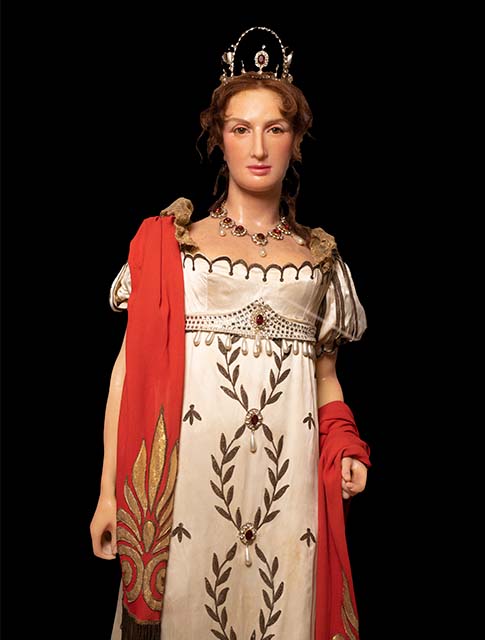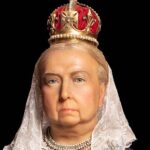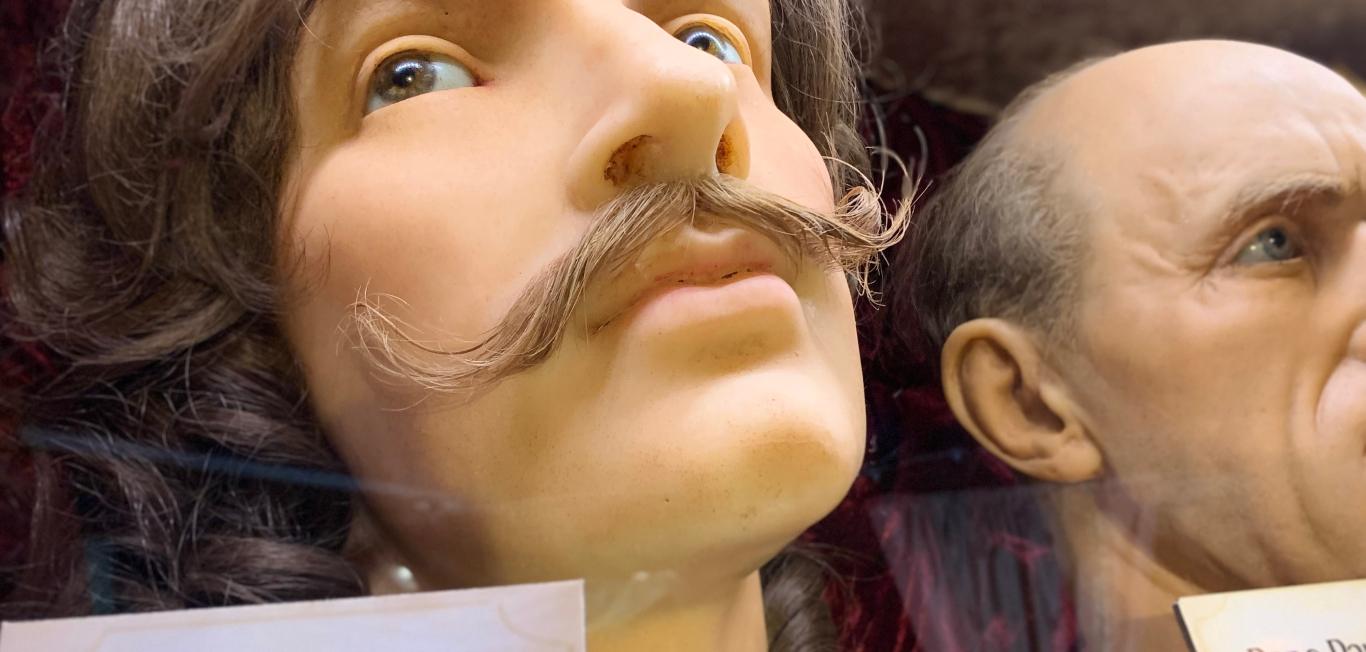About Joséphine de Beauharnais Bonaparte
Joséphine de Beauharnais, born Marie Josèphe Rose Tascher de la Pagerie, lived a remarkable life. Born in 1763 in Martinique, she married Alexandre de Beauharnais at age 16 and moved to Paris. After his execution during the Reign of Terror in 1794, the widowed de Beauharnais navigated the dangerous political waters of post-revolutionary France. She cultivated relationships with powerful men such as Paul Barras before meeting the young Napoleon Bonaparte in 1795. Captivated by de Beauharnais’ grace and charm, Bonaparte married her in 1796 as his military career took off. Joséphine de Beauharnais suffered humiliation from Bonaparte’s family. However, she played an important public role as his wife and as a political hostess. In 1804, Bonaparte crowned de Beauharnais empress, but political necessity forced him to divorce her in 1810 due to her inability to bear him an heir. Even so, Bonaparte’s last words referenced the enduring connection he felt to Joséphine de Beauharnais. Banished to Malmaison after the divorce, de Beauharnais dedicated her final years to gardening before her death in 1814.
Early Years
Joséphine de Beauharnais (née Marie Josèphe Rose Tascher de la Pagerie) was born on June 23, 1763, in Martinique. She lived the first 15 years of her life on the Caribbean island, which was then a French colony. Born on the family sugar plantation, called La Petite Guinée, de Beauharnais enjoyed a privileged, carefree childhood as the eldest daughter of Joseph Tascher de la Pagerie, an aristocrat grown poor from mismanaging the plantation. The family’s wealth and status depended on the labor of the 300 enslaved people who worked on the plantation. From a young age, slavery was a simple fact of life for de Beauharnais. After her maternal grandfather died in 1766, the family fortunes declined steadily, forcing Joséphine’s father to demand she marry Alexandre de Beauharnais at age 16 in 1779 to support the family. The marriage was arranged by her aunt, who was the wife of Alexandre’s uncle. Though not a happy match, the union brought social advantages and financial relief to both families. The marriage would produce two children over the next few years — Eugène in 1781 and Hortense in 1783. But Alexandre proved an absent figure, traveling for long stretches while Joséphine struggled in unfamiliar Parisian high society, her unsophisticated manners hampering acceptance.
DID YOU KNOW?
Joséphine de Beauharnais lived the first 15 years of her life on the Caribbean island of Martinique.
Personal Life
Joséphine de Beauharnais lived in Paris with her husband Alexandre, Vicomte de Beauharnais, a young and wealthy officer in the army. However, Alexandre neglected and mistreated Joséphine, leading her to seek a separation in 1785. During the French Revolution’s Reign of Terror, Alexandre was imprisoned and executed, and Joséphine was also jailed before being freed after the Fall of Robespierre. The now-widowed Joséphine de Beauharnais became involved with several powerful political figures, including Paul Barras.
In 1795, the 30-year-old Napoleon Bonaparte became infatuated with the 32-year-old Joséphine de Beauharnais after meeting her at a social event. In March 1796, Bonaparte married Joséphine de Beauharnais, who would become the first wife of the future Emperor Napoleon I. Bonaparte adored de Beauharnais and wrote many romantic letters, but she was initially less enthused about the marriage. As Bonaparte rose to power as first consul and then emperor, Joséphine de Beauharnais assumed an important public role as his consort and hostess. On December 2, 1804, six years after their wedding, Joséphine de Beauharnais was crowned by Napoleon as empress of the French, a role she held until 1810. Despite marital troubles over Josephine’s spending and rumored infidelity, Bonaparte remained devoted to her, refusing to divorce her until she failed to produce an heir.
Interesting Facts About Joséphine de Beauharnais Bonaparte
There is a city called Josephine in Texas named after her.
De Beauharnais was passionate about roses and cultivated an extensive collection at her residence, Château de Malmaison. She wrote one of the first histories documenting the cultivation of roses. Bonaparte nicknamed her “Rose,” but she was also known as Joséphine de Beauharnais after her first marriage.
Through her daughter Hortense, de Beauharnais is an ancestor of the current royal houses of Greece, Norway, Belgium, Denmark, Luxembourg, and Sweden.
Her taste for fashion was trendsetting in Paris, and she was one of the first to wear audacious neo-Greek fashion.
De Beauharnais used her charm and taste to advance Bonaparte’s career, acting as his ambassador and as a hostess for visiting dignitaries.
She is regarded as one of the 19th century’s most significant female figures.
Joséphine de Beauharnais’
Influence in History
Joséphine de Beauharnais was the first wife of Napoleon I, Emperor of the French. She was renowned as a trendsetter in fashionable Parisian society. She popularized the daring body-hugging neo-Greek dress style and was among the first to adopt chemise gowns cut very low in the front and back. As empress of the French from 1804 to 1809, de Beauharnais hosted legendary parties and receptions that revived court ceremonies while her taste for elegant yet comfortable furniture and interior design influenced the empire’s style. Remembered as one of the 19th century’s most prominent women, de Beauharnais promoted the arts, patronized talented artists like Prud’hon, and created renowned rose gardens at her residence of Château de Malmaison. Her graceful charm and political savvy aided Bonaparte’s rise, leading some to state that she said, “You are nothing without me.”
DID YOU KNOW?
Joséphine de Beauharnais popularized the daring body-hugging neo-Greek dress style.
Late in Life
Joséphine de Beauharnais died in 1814 at the age of 51. She contracted deadly pneumonia and passed away at the stately Malmaison on May 29, 1814. Four days after her death, Josephine’s funeral took place at the church of Saint-Pierre-Saint-Paul in Rueil-Malmaison. Today, de Beauharnais’ tomb in the church still features a recumbent statue of the former empress of the French standing over it.
Though their marriage ultimately ended in divorce, Bonaparte cared for de Beauharnais deeply, once remarking that the only conflict between them was her lavish spending habits. Upon learning of de Beauharnais’ death while in exile in Elba in 1814, Bonaparte reportedly shut himself away and refused visitors for two days, grieving over the loss of his former wife and empress. Even in his final days, Bonaparte’s last words referenced “Joséphine,” speaking to her enduring impact and place in his life story.
FAQs
Was Joséphine de Beauharnais involved in any political affairs during her time as empress?
There is no evidence that supports de Beauharnais being directly involved in political decisions or policies during her time as empress. However, she did entertain and meet with important political figures as part of her ceremonial duties. Some also suggest she may have indirectly influenced certain policies related to slavery due to her connections with the Caribbean plantation system.
Did de Beauharnais have any siblings?
Yes, Joséphine de Beauharnais had two younger sisters: Catherine-Désirée and Marie-Françoise. In total, she had five surviving siblings.
What was Joséphine de Beauharnais’ upbringing like?
De Beauharnais had a relatively privileged, carefree upbringing in Martinique, thanks to her family’s wealth from sugar plantations worked by slaves. However, the family fortunes declined during her childhood due to her father’s financial mismanagement.
Why is Joséphine de Beauharnais important in French history?
De Beauharnais is an important figure in French history as Napoleon Bonaparte’s first wife and empress of the French from 1804 to 1810. As empress, she helped establish some traditions of courtly life, entertaining dignitaries and representing the emperor. Though unable to bear Bonaparte an heir, her children became important figures as well, meaning she is an ancestor to later monarchs in Europe. Her extravagance and style also made her an arbiter of fashion in her era.
What are the names of de Beauharnais’ descendants?
Through her son Eugène, de Beauharnais was grandmother to Joséphine of Leuchtenberg, who married King Oscar I of Sweden. This makes her an ancestor of the current Swedish, Danish, Belgian, and Norwegian royal families. Her daughter Hortense married Napoleon’s brother, Louis Bonaparte, making de Beauharnais great-grandmother to Napoleon III, Emperor of France.










